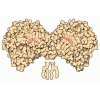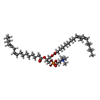[English] 日本語
 Yorodumi
Yorodumi- PDB-1ln1: Crystal Structure of Human Phosphatidylcholine Transfer Protein i... -
+ Open data
Open data
- Basic information
Basic information
| Entry | Database: PDB / ID: 1ln1 | ||||||
|---|---|---|---|---|---|---|---|
| Title | Crystal Structure of Human Phosphatidylcholine Transfer Protein in Complex with Dilinoleoylphosphatidylcholine | ||||||
 Components Components | Phosphatidylcholine transfer protein | ||||||
 Keywords Keywords | LIPID BINDING PROTEIN / START Domain | ||||||
| Function / homology |  Function and homology information Function and homology informationphosphatidylcholine transporter activity / Mitochondrial Fatty Acid Beta-Oxidation / phospholipid transport / phosphatidylcholine binding / negative regulation of cold-induced thermogenesis / lipid transport / Synthesis of PC / cytosol Similarity search - Function | ||||||
| Biological species |  Homo sapiens (human) Homo sapiens (human) | ||||||
| Method |  X-RAY DIFFRACTION / X-RAY DIFFRACTION /  SYNCHROTRON / SYNCHROTRON /  MOLECULAR REPLACEMENT / Resolution: 2.4 Å MOLECULAR REPLACEMENT / Resolution: 2.4 Å | ||||||
 Authors Authors | Roderick, S.L. / Chan, W.W. / Agate, D.S. / Olsen, L.R. / Vetting, M.W. / Rajashankar, K.R. / Cohen, D.E. | ||||||
 Citation Citation |  Journal: Nat.Struct.Biol. / Year: 2002 Journal: Nat.Struct.Biol. / Year: 2002Title: Structure of human phosphatidylcholine transfer protein in complex with its ligand. Authors: Roderick, S.L. / Chan, W.W. / Agate, D.S. / Olsen, L.R. / Vetting, M.W. / Rajashankar, K.R. / Cohen, D.E. | ||||||
| History |
|
- Structure visualization
Structure visualization
| Structure viewer | Molecule:  Molmil Molmil Jmol/JSmol Jmol/JSmol |
|---|
- Downloads & links
Downloads & links
- Download
Download
| PDBx/mmCIF format |  1ln1.cif.gz 1ln1.cif.gz | 57.1 KB | Display |  PDBx/mmCIF format PDBx/mmCIF format |
|---|---|---|---|---|
| PDB format |  pdb1ln1.ent.gz pdb1ln1.ent.gz | 41.1 KB | Display |  PDB format PDB format |
| PDBx/mmJSON format |  1ln1.json.gz 1ln1.json.gz | Tree view |  PDBx/mmJSON format PDBx/mmJSON format | |
| Others |  Other downloads Other downloads |
-Validation report
| Summary document |  1ln1_validation.pdf.gz 1ln1_validation.pdf.gz | 465.6 KB | Display |  wwPDB validaton report wwPDB validaton report |
|---|---|---|---|---|
| Full document |  1ln1_full_validation.pdf.gz 1ln1_full_validation.pdf.gz | 473.5 KB | Display | |
| Data in XML |  1ln1_validation.xml.gz 1ln1_validation.xml.gz | 7.7 KB | Display | |
| Data in CIF |  1ln1_validation.cif.gz 1ln1_validation.cif.gz | 10.6 KB | Display | |
| Arichive directory |  https://data.pdbj.org/pub/pdb/validation_reports/ln/1ln1 https://data.pdbj.org/pub/pdb/validation_reports/ln/1ln1 ftp://data.pdbj.org/pub/pdb/validation_reports/ln/1ln1 ftp://data.pdbj.org/pub/pdb/validation_reports/ln/1ln1 | HTTPS FTP |
-Related structure data
- Links
Links
- Assembly
Assembly
| Deposited unit | 
| ||||||||
|---|---|---|---|---|---|---|---|---|---|
| 1 |
| ||||||||
| Unit cell |
|
- Components
Components
| #1: Protein | Mass: 24871.301 Da / Num. of mol.: 1 Source method: isolated from a genetically manipulated source Source: (gene. exp.)  Homo sapiens (human) / Production host: Homo sapiens (human) / Production host:  |
|---|---|
| #2: Chemical | ChemComp-DLP / |
| #3: Water | ChemComp-HOH / |
| Has protein modification | Y |
-Experimental details
-Experiment
| Experiment | Method:  X-RAY DIFFRACTION / Number of used crystals: 1 X-RAY DIFFRACTION / Number of used crystals: 1 |
|---|
- Sample preparation
Sample preparation
| Crystal | Density Matthews: 3.7 Å3/Da / Density % sol: 66.8 % | ||||||||||||||||||||||||
|---|---|---|---|---|---|---|---|---|---|---|---|---|---|---|---|---|---|---|---|---|---|---|---|---|---|
| Crystal grow | Temperature: 298 K / Method: vapor diffusion, hanging drop / pH: 5.5 Details: sodium formate, sodium acetate, pH 5.5, VAPOR DIFFUSION, HANGING DROP, temperature 298K | ||||||||||||||||||||||||
| Crystal grow | *PLUS pH: 5.7 | ||||||||||||||||||||||||
| Components of the solutions | *PLUS
|
-Data collection
| Diffraction | Mean temperature: 117 K |
|---|---|
| Diffraction source | Source:  SYNCHROTRON / Site: SYNCHROTRON / Site:  NSLS NSLS  / Beamline: X9A / Wavelength: 0.94645 Å / Beamline: X9A / Wavelength: 0.94645 Å |
| Detector | Type: MARRESEARCH / Detector: CCD / Date: Mar 16, 2001 |
| Radiation | Monochromator: graphite / Protocol: SINGLE WAVELENGTH / Monochromatic (M) / Laue (L): M / Scattering type: x-ray |
| Radiation wavelength | Wavelength: 0.94645 Å / Relative weight: 1 |
| Reflection | Resolution: 2.4→25.4 Å / Num. all: 14602 / Num. obs: 14602 / % possible obs: 98.1 % / Observed criterion σ(F): 0 / Observed criterion σ(I): 0 / Biso Wilson estimate: 31.3 Å2 / Rmerge(I) obs: 0.036 |
| Reflection shell | Resolution: 2.4→2.55 Å / % possible all: 99.6 |
| Reflection | *PLUS Num. measured all: 135402 |
| Reflection shell | *PLUS Lowest resolution: 2.49 Å / % possible obs: 99.6 % / Rmerge(I) obs: 0.231 |
- Processing
Processing
| Software |
| ||||||||||||||||||||||||||||||||||||||||||||||||||||||||||||||||||||||||||||||||
|---|---|---|---|---|---|---|---|---|---|---|---|---|---|---|---|---|---|---|---|---|---|---|---|---|---|---|---|---|---|---|---|---|---|---|---|---|---|---|---|---|---|---|---|---|---|---|---|---|---|---|---|---|---|---|---|---|---|---|---|---|---|---|---|---|---|---|---|---|---|---|---|---|---|---|---|---|---|---|---|---|---|
| Refinement | Method to determine structure:  MOLECULAR REPLACEMENT / Resolution: 2.4→25.38 Å / Rfactor Rfree error: 0.011 / Isotropic thermal model: RESTRAINED / Cross valid method: THROUGHOUT / σ(F): 2 / Stereochemistry target values: Engh & Huber MOLECULAR REPLACEMENT / Resolution: 2.4→25.38 Å / Rfactor Rfree error: 0.011 / Isotropic thermal model: RESTRAINED / Cross valid method: THROUGHOUT / σ(F): 2 / Stereochemistry target values: Engh & Huber
| ||||||||||||||||||||||||||||||||||||||||||||||||||||||||||||||||||||||||||||||||
| Solvent computation | Solvent model: FLAT MODEL / Bsol: 55.2738 Å2 / ksol: 0.397764 e/Å3 | ||||||||||||||||||||||||||||||||||||||||||||||||||||||||||||||||||||||||||||||||
| Refine analyze | Luzzati coordinate error free: 0.47 Å / Luzzati sigma a free: 0.52 Å | ||||||||||||||||||||||||||||||||||||||||||||||||||||||||||||||||||||||||||||||||
| Refinement step | Cycle: LAST / Resolution: 2.4→25.38 Å
| ||||||||||||||||||||||||||||||||||||||||||||||||||||||||||||||||||||||||||||||||
| Refine LS restraints |
| ||||||||||||||||||||||||||||||||||||||||||||||||||||||||||||||||||||||||||||||||
| LS refinement shell | Highest resolution: 2.4 Å / Total num. of bins used: 6 /
| ||||||||||||||||||||||||||||||||||||||||||||||||||||||||||||||||||||||||||||||||
| Xplor file |
| ||||||||||||||||||||||||||||||||||||||||||||||||||||||||||||||||||||||||||||||||
| Refinement | *PLUS % reflection Rfree: 5 % / Rfactor Rwork: 0.237 | ||||||||||||||||||||||||||||||||||||||||||||||||||||||||||||||||||||||||||||||||
| Solvent computation | *PLUS | ||||||||||||||||||||||||||||||||||||||||||||||||||||||||||||||||||||||||||||||||
| Displacement parameters | *PLUS | ||||||||||||||||||||||||||||||||||||||||||||||||||||||||||||||||||||||||||||||||
| Refine LS restraints | *PLUS
| ||||||||||||||||||||||||||||||||||||||||||||||||||||||||||||||||||||||||||||||||
| LS refinement shell | *PLUS Highest resolution: 2.4 Å / Lowest resolution: 2.49 Å / Rfactor Rfree: 0.406 / Rfactor Rwork: 0.384 |
 Movie
Movie Controller
Controller





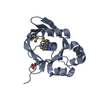
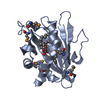

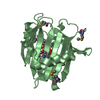
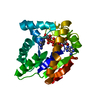
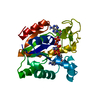
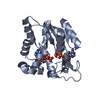
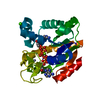
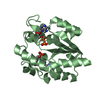
 PDBj
PDBj
